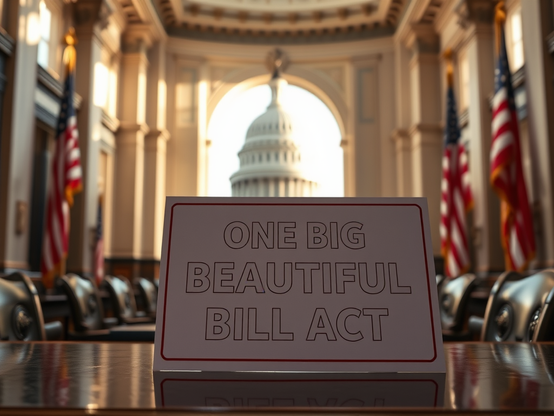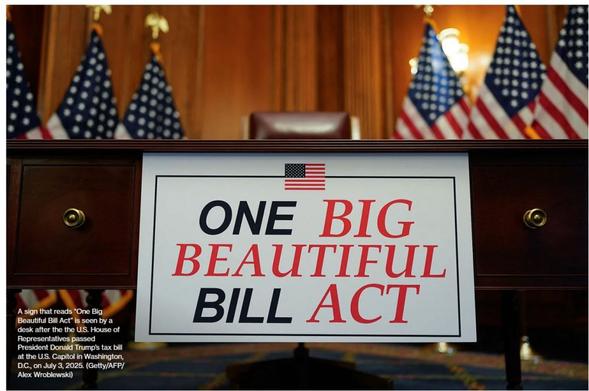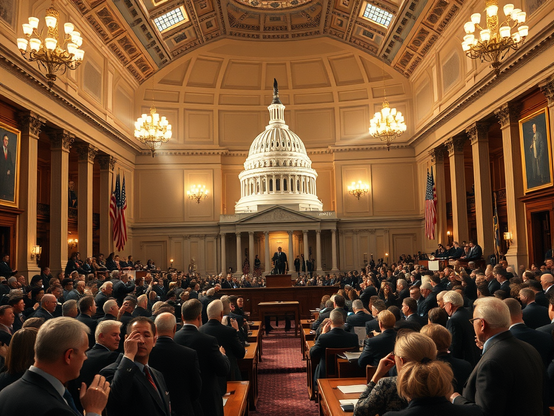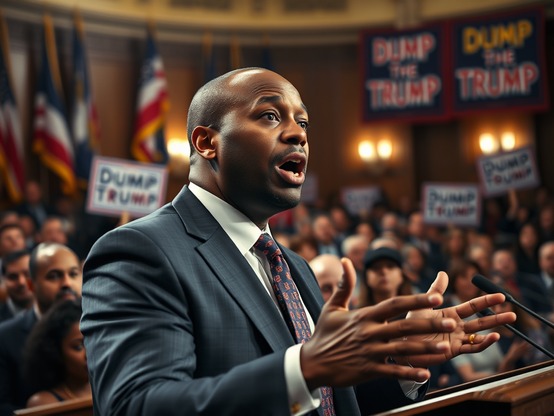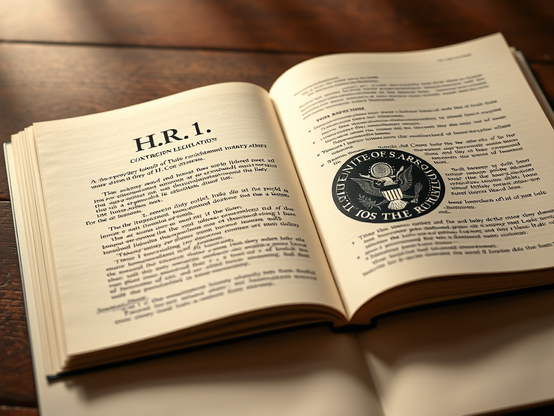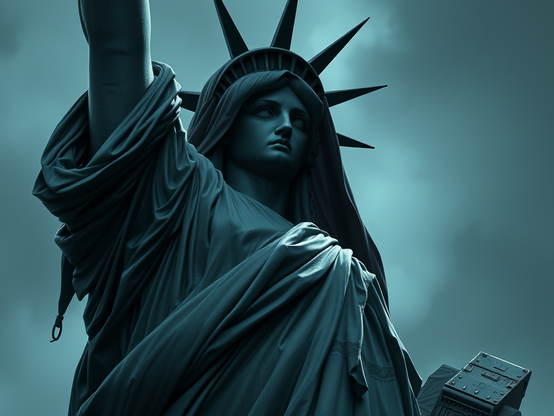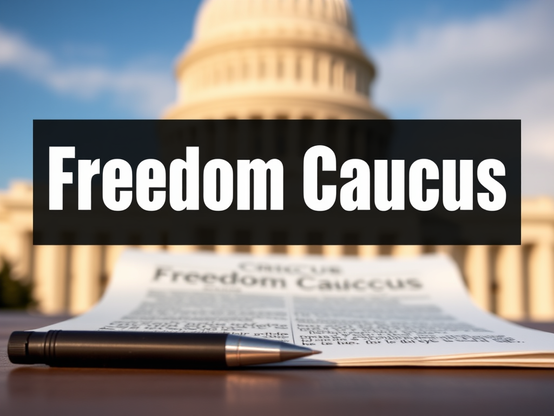Jul 3, 2025
The Truth About the One Big Beautiful Bill Act’s Cuts to Medicaid and Medicare
The Center for American Progress and The Arc break down the One Big Beautiful Bill Act, exposing how its deep cuts to Medicaid and Medicare will lead to benefit losses, increased paperwork requirements, and rural hospital closures that will hurt Americans—especially people with disabilities.
By Mia Ives-Rublee, andKim Musheno
A sign that reads “One Big Beautiful Bill Act” is seen by a desk after the the U.S. House of Representatives passed President Donald Trump’s tax bill at the U.S. Capitol in Washington, D.C., on July 3, 2025. (Getty /AFP/ Alex Wroblewski)This column is a collaboration between the Center for American Progress and The Arc.
Authors’ note: The disability community is rapidly evolving to use identity-first language in place of person-first language. This is because it views disability as being a core component of identity, much like race and gender. Some members of the community, such as people with intellectual and developmental disabilities, prefer person-first language. In this column, the terms are used interchangeably.
On July 3, Congress passed the sweeping, regressive One Big Beautiful Bill Act (OBBBA). Amid the self-imposed rush to deliver the bill to President Donald Trump’s desk by July 4, many Americans will be looking for information about the bill, which was largely debated in the dead of night and pushed through at breakneck speed. This confusion has only been exacerbated by misleading and inaccurate statements about how and whether the bill’s cuts will affect people with disabilities.
In this column, the Center for American Progress and The Arc address the rhetoric surrounding the bill and unpack the devastating impacts that its deep cuts to Medicaid and Medicare, in particular, will have on people with disabilities.
Those who need Medicaid most, including people with disabilities and the elderly, will be affected by the bill’s cuts
The nonpartisan Congressional Budget Office (CBO) estimated that the OBBBA will cut federal spending on Medicaid and Children’s Health Insurance Program (CHIP) benefits by $1.02 trillion, due in part to eliminating at least 10.5 million people from the programs by 2034. With new federal limits on Medicaid eligibility likely increasing the number of uninsured, along with other provisions that restrict states’ ability to raise revenue to fund their Medicaid programs, states will have to reevaluate their budgets to either supplement the spending or cut services. Research shows that when federal funding for Medicaid decreases, states tend to cut optional benefits such as home- and community-based (HCBS) first. It is nearly impossible to carve out a specific population, such as disabled people or elderly people, because the cuts to Medicaid funding will affect everyone due to hospital closures and health care workforce layoffs.
The bill will make it harder for states to fund home- and community-based services
The OBBBA creates a new category in 1915(c) HCBS waivers that will cover people who do not meet the existing requirement of needing an institutional level of care to receive HCBS. States would be allowed to apply to access this funding as long as their proposed program does not increase the average HCBS wait times for people who meet the need for institutional care. In order to implement this additional category, the federal government will provide $50 million in fiscal year 2026 and $100 million in fiscal year 2027. In 2020, average Medicaid per capita spending on HCBS was $36,275. Yet in the first year of the bill’s new HCBS waiver, funds from the bill would only be able to cover HCBS costs for about 27 people per state—without accounting for overhead spending or inflation. Moreover, states will be contending with massive federal funding losses due to the bill’s Medicaid cuts, which will likely lengthen wait times for HCBS, making them ineligible to establish the new category at all.
Medicaid paperwork requirements will cause eligible people to lose coverage
While some advocates of the One Big Beautiful Bill Act have claimed that it will “[stop] the subsidization of competent adults who are just choosing to not work,” the reality is that nearly all Medicaid recipients who aren’t automatically eligible based on Supplemental Security Income (SSI) or Social Security Disability Insurance (SSDI) and are able to work are already working. Indeed, only 8 percent of recipients between the ages of 19 and 64 who weren’t on SSI or SSDI in 2023 “[weren’t] working due to retirement, inability to find work, or other reason[s].” Those who were not working were statistically more likely to be older women who left the workforce to care for aging parents or children.
The OBBBA requires individuals to prove that they are working, engaging in community service, or receiving work training for at least 80 hours per month—or that they are enrolled in school part time—unless they qualify for an exemption. Medicaid enrollees who are trying to find a job, are having difficulty finding employment, or who lack reliable transportation to work would be penalized under this requirement. That includes at least more than 2.6 million adults with disabilities who don’t have SSI or SSDI and have difficulty working due to disability or illness.
Research indicates that paperwork requirements such as those in the bill—particularly for Medicaid—don’t increase employment rates and often increase overhead costs. A group of researchers evaluated the first year of paperwork reporting requirements in Arkansas and found that there was a significant loss of Medicaid coverage in the initial six months among eligible people and no significant change in employment. Georgia also implemented a trial program, called Pathways, that included paperwork requirements, and state caseworkers found the monthly verification of employment overly burdensome. To date, taxpayers have spent more than $86 million on Pathways only to have 6,500 participants enrolled in the first 18 months of the program—75 percent fewer enrollees than the state had estimated would participate in year one.
The bill will put rural hospitals at risk
Read more: The Truth About the One Big Beautiful Bill Act’s Cuts to Medicaid and Medicare – Center for American ProgressSource Links: The Truth About the One Big Beautiful Bill Act’s Cuts to Medicaid and Medicare – Center for American Progress




